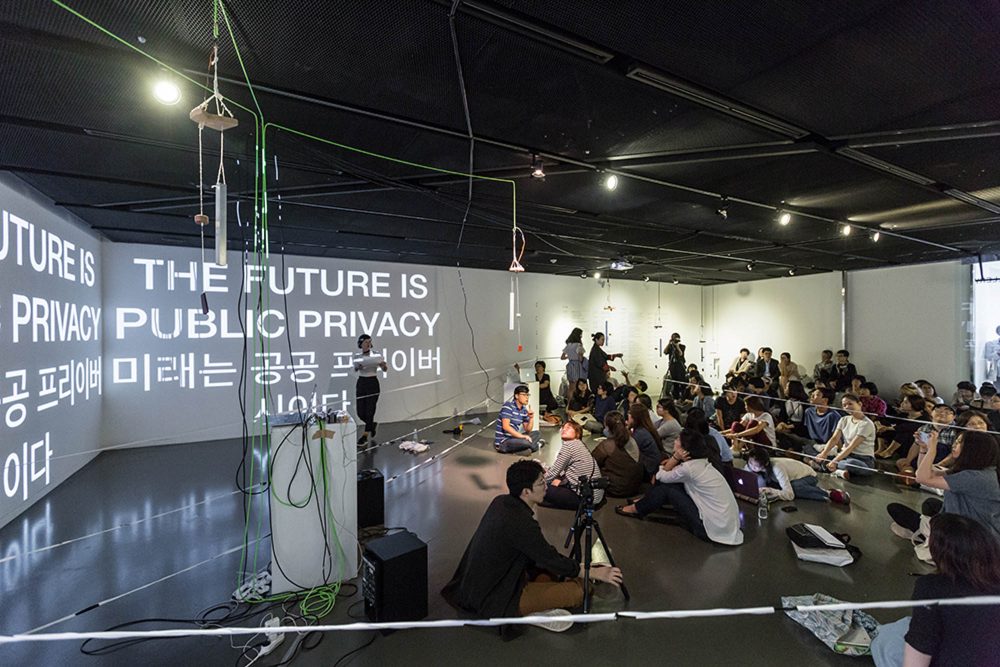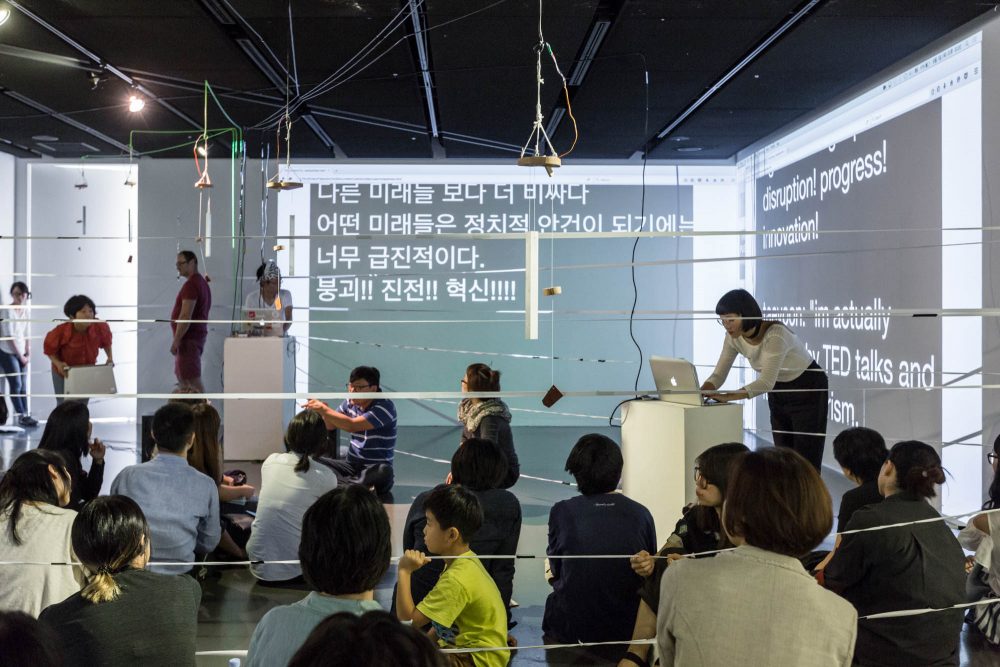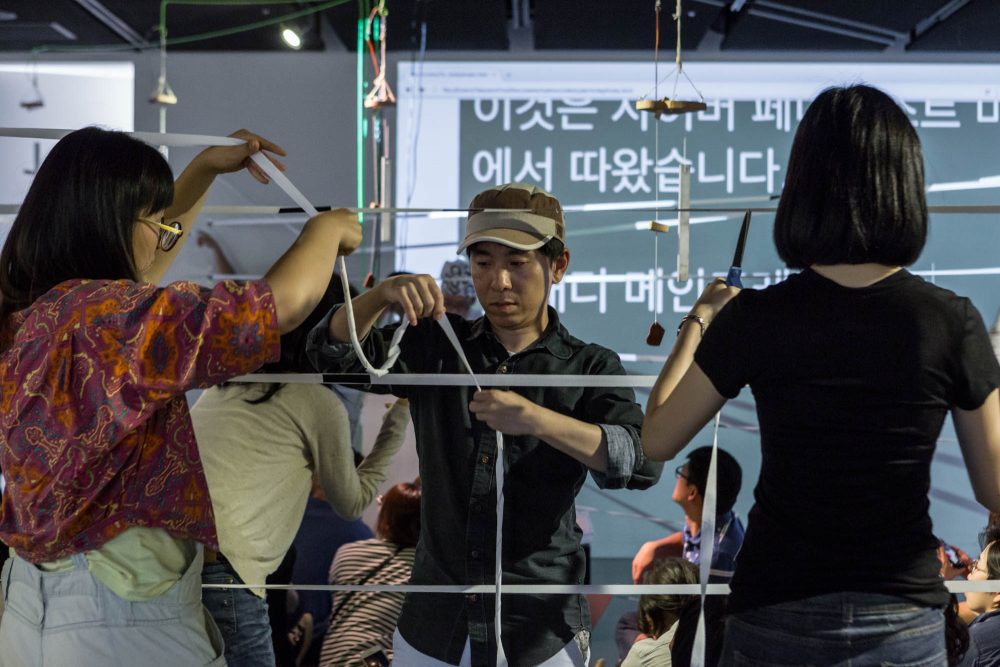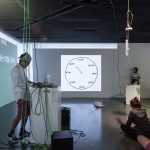
A collaboration by Taeyoon Choi and Christine Sun Kim
In the traditional sense of time, a bell-ringer notifies the hour of the day and notifies people to attend religious or public services. In a different sense of time, the wind chimes make the passing of time noticeable. It renders time as abstract rather than a series of numeric marks.
However, contemporary time is now controlled by Network Time Protocol (in other words, the Internet time) which synchronize the clocks of computers and phones around the world. This time is the new territory that constructs our sense of place. The concept of Future has become the perpetual Present.
For this lecture performance, we came up with seven potential futures and gave form to them as wind chimes with electronics and motors. As each wind chime creates sound in various speeds, they will gradually become one collective and intersectional future, in both controlled and abstract senses.
THE FUTURE IS DEAFHOOD
THE FUTURE IS CODING
THE FUTURE IS PUBLIC PRIVACY
THE FUTURE IS RATING TRUST
THE FUTURE IS EXPENSIVE SOLUTION
THE FUTURE IS POST DWELLING
THE FUTURE IS CYBERFEMINIST












Photographs: SeMA Biennale Mediacity Seoul 2016
An excerpt from the script.
We wrote this lecture together, over few months. It’s a collective voice, a statement and a proposition.
2 – THE FUTURE IS CODING
Code is the New Language. It’s a language not a technology. Signing is a language, not a technology.
Code, in itself, is the language that doesn’t discriminate race, gender, disability or other differences. However the culture of code and technology is often not welcoming or inviting.
On the other hand, we struggle to legitimize signing as language in many countries. We are very happy that KSL is legitimized this year. Our language is now in the right place, we still got a lot work to do.
Then. How do we translate non-digital languages… such as ASL and KSL? How do we use Code a shared language between people who communicate and learn differently?
We wrote the software for the windchimes. It’s only about 150 lines of code. The Object Oriented Programming method allows programmers to write short code, and recycle much of the code for various applications.
“Technology will save us!” This sort of logic of tech saviorism persists everywhere. Technology can help the disabled person communicate. In reality, such technology fails to be widely used because of lack of adaptability.
The signing glove will not work, not because of technical challenges, but because it’s design does not respect how deaf people communicate in real life. The Deaf identity in the community widely varies due to all different levels of deafness and relationship with the Deaf community, which is why it’s extremely critical that the coders/developers include a number of Deaf people in every stage (or even invite them as collaborators), rather than developing based on hearing people’s assumptions of what Deaf people should experience, then test on them like monkeys.
Does every Deaf person want to experience/feel music? No. I appreciate your good intentions but no thanks.
The mainstream narrative of “I have this disability but I’ve overcome it and feel such and such” is more harmful than helpful. It’s a forced regulation (fitting the person into the standards of the ‘normal’) in the name of empowerment. We need to look at bringing equity to social values, this starts by bringing accessibility and inclusion in the field of science, engineering, and most importantly in the arts.
We want to see more tech ideas that are based on deaf experience by deaf people, not hearing people’s idea of what deaf experience may be.
2. 그 미래는 코딩이다
코드란 새로운 언어이다. 기술이 아닌 언어이다. 수화는 언어이다, 기술이 아니다.
코드 그자체는 인종, 성, 장애나 다름을 차별하는 언어가 아니다. 그러나 코드와 기술의 문화는 간혹 환영이나 초대를 받지 못한다.
반대로, 우리는 수화를 다른나라에서도 쓸 수 있는 공동언어라 정당화 하려고 애쓴다. 우리는 한국 수어가 올해 공식언어가 됐음이 기쁘다. 우리의 언어는 이제 있어야 할 자리에 있고, 아직도 많은 변화를 주어야 한다.
그렇다면, 어떻게 디지털화 되어있지 않은 언어를 번역해야 할까… ASL과 KSL과 같은 것을…? 어떻게 Code를 사용해야 할까, 사람들 사이에서 다르게 대화가 되고 다르게 배운 공통의 언어를?
풍경들을 위해 소프트웨어를 적었다. 고작 150줄의 코드들이다. The Object Oriented Programming 방법은 프로그래머들에게 짧은 코드를 쓰게, 또 많은 코드들을 다양하게 적용할 수 있도록 재활용 하게끔 만들어 준다.
기술은 우리를 살려줄 것이다! 기술이 우리를 구원할 것이라는 논리는 모든 곳에 산재해 있다. 기술은 장애인이 의사소통을 하는데 도와줄 수 있다. 그러나 현실에서 이러한 기술은 적응성의 부족으로 널리 이용되지 못한다.
싸이닝 글러브는 기술의 부족 때문이 아니라, 청각 장애인이 실제로 어떻게 의사소통을 하는지에 대해 제대로 이해하고 존중하지 않는 디자인 때문에 소용이 없다. 청각 장애인 커뮤니티 안에서의 정체성은 청각 장애의 정도에 따라 매우 다양하며, 그렇기 때문에 비청각장애인의 단순한 추정으로 싸이닝 글러브를 만든 뒤 청각 장애인에게 실험할 것이 아니라, 코딩 프로그래머와 개발자가 모든 단계에서 청각 장애인을 포함하여 일을 진행하는 것이 중요하다.
모든 청각 장애인이 음악을 경험하고 느끼고 싶어하는가? 그렇지 않다. 선한 의도는 감사하지만 거절한다.
“난 이런 장애가 있지만 난 극복했고 난 이렇게 저렇게 느꼈습니다”의 주류적인 서술은 도움이 되기보다는 해가 된다. 이것은 ‘권한’의 이름 아래 억지로 강요된 규제와 규정(그 사람을 ‘정상’의 기준에 끼워 맞추는 것)이다. 우리는 사회적 가치에 ‘평등’을 가져와야 하며, 이것은 과학, 엔지니어링, 그리고 가장 중요하게는 예술에 접근 가능성과 모든 이를 포함하는 일로부터 시작된다.
FUTURE PROOF
09.01, 5:00pm — 7:00pm
Project Gallery, Seoul Museum of Art Seosomun Main Building 3F (map)
Lecture Performance
* FUTURE PROOF will be performed in both written English and Korean, plus Korean Sign Language and American Sign Languages. The performance will require audience participation.
Text from SeMA Biennale Mediacity Seoul 2016 website.
